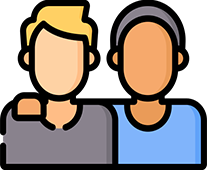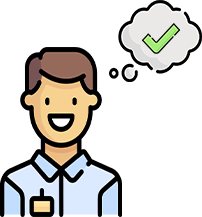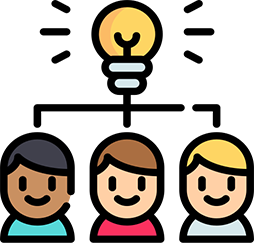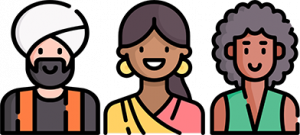4.3: Uncovering Unconscious Bias
An unconscious bias (also known as implicit bias) is an implicit attitude, stereotype, motivation, or assumption that can occur without one’s knowledge, control or intention. Unconscious bias is a result of our life experiences and affects all types of people. Examples of unconscious bias include gender bias, cultural bias, age bias, language, and institutional bias.
The following video, Understanding unconscious bias [2:59] by Royal Society (2015), gives an overview of unconscious bias.
Unconscious biases are important to recognize in instances when quality, relevance and competence are being evaluated (University of California San Francisco, n.d.).
Types of Unconscious Bias
A vast body of research on unconscious bias shows that there are approximately 150 different types of unconscious biases. Given the various kinds of unconscious biases, all of us must be aware of our own unconscious biases. There are four fundamental unconscious biases (Kelley, 2020):
Affinity Bias

Affinity bias (also known as the similarity bias) is when people like people who are perceived to be just like them. Any perceived connection, however big or small, can result in an affinity bias. Affinity bias is fertile ground for the exclusion of people. Our natural instinct to gravitate towards people who are like us. But making decisions solely on someone who is like ourself can cause tunnel vision.
The PwC (2017) video, Blind spots: Broaden perspectives [3:24], discusses similarity bias and how to overcome it.
Confirmation Bias

Confirmation biases are realized when people attempt to prove assumptions and stereotypes. Confirmation bias impacts the organizational culture since people seek to confirm their beliefs or stereotypes in their interactions. Confirmation bias can affect assignments to work teams, and opportunities to participate in decision-making processes. People who exhibit confirmation bias do so after learning some aspect about a person or group and will then unconsciously seek confirmation or search for evidence to prove their assumptions. Remote learning can exacerbate confirmation bias since there is less opportunity to get to know people due to limited contact, whereas people will spend time confirming instead of getting to know someone.
Groupthink or Conformity Bias

Perception Bias

Perception bias is when people form generalized stereotypes and assumptions about particular groups of people. This type of bias renders it virtually impossible for people with this bias to remain objective when considering an individual in any aspect of the learning environment. Perception bias is present when a person focuses on irrelevant factors about someone they are perceiving (such as their gender, ethnicity, race, national origin, sexual orientation, etc.) and the stereotypes associated with each, rather than the qualifications and personality of the individual.
Conscious Bias
Conscious Bias (also known as explicit bias) refers to the prejudiced beliefs or attitudes one has towards a person or group on a conscious level. Explicit attitudes are feelings and thoughts that one deliberately believes and can consciously document.
Unconscious biases are social stereotypes about certain groups of people that individuals form outside their own conscious awareness. Everyone holds unconscious beliefs about various social and identity groups, and these biases stem from one’s tendency to organize social worlds by categorizing.
It is important to note that biases, conscious or unconscious, are not limited to ethnicity and race. Though racial bias and discrimination are well documented, biases may exist toward any social group. One’s age, gender, gender identity, physical abilities, religion, sexual orientation, weight, and many other characteristics are subject to bias.
Addressing and Combating Bias
The Devex (2018) video, 4 steps for busting unconscious bias [4:26], details a step-by-step guide for recognizing and responding to our own unconscious biases.
The Center for Teaching and Learning (n.d.) at DePaul University provides some strategies for combating bias in teaching:
- Consider using grading and assessment techniques that may help mitigate bias
- Diversify curriculum which may help to counter stereotypes
- Facilitate equitable participation during class activities and discussions
- Ask for feedback from peers by asking a colleague to observe your course
You may read the detailed strategies from Implicit Bias![]() .
.
Activity 3: Identify Biases
- Take the Project Implicit
 online self-assessment by Harvard University to identify your individual biases.
online self-assessment by Harvard University to identify your individual biases. - Review the examples below and self-reflect on lived experiences related to your own biases:
- Instructors may assume that certain students know to seek help when they are struggling, although students at higher risk for struggling academically are often less likely to seek help and support.
- Instructors may assume that students from certain backgrounds or social groups have differing intellectual abilities and/or ambitions. For example, an instructor might assume that a student from a certain background will be satisfied with lower achievement levels.
- Instructors may expect students who speak with certain accents to be poor writers.
- Instructors may stereotype students with substandard writing abilities as lacking intellectual ability.
- Instructors might treat students with physical disabilities as if they may also have mental disabilities, and thus require more attention.
- Instructors may treat students who are affiliated with a particular identity group as experts on issues related to that group.
- Instructors may assume that students will best relate to the historical, contemporary, or fictional character who resembles them demographically.
- Instructors may expect students of certain groups to have certain participation styles (quiet, argumentative, agenda-oriented).
You are invited to record your reflection in the way that works best for you, which may include writing, drawing, creating an audio or video file, mind map or any other method that will allow you to document your ideas and refine them at the end of this module.
Alternatively, a text-based note-taking space is provided below. Any notes you take here remain entirely confidential and visible only to you. Use this space as you wish to keep track of your thoughts, learning, and activity responses. Download a text copy of your notes before moving on to the next page of the module to ensure you don’t lose any of your work!
References
Center for Teaching and Learning. (n.d.). Implicit Bias. DePaul University. https://resources.depaul.edu/teaching-commons/teaching-guides/inclusive-teaching/Pages/implicit-bias.aspx
Devex. (2018, Mar 26). 4 steps for busting unconscious bias [Video]. YouTube. https://youtu.be/K-n7el87Dmo
Kelley, R. (2020, Jun 24). Unconscious bias during a crisis. Kelley Consulting Firm. https://www.kelleyconsultingfirm.com/post/unconscious-bias-during-a-crisis
PwC. (2017, Jun 23). Blind spots: Broaden perspectives [Video]. YouTube. https://youtu.be/HbBTM8bJt8QThe
Royal Society. (2015, Nov 17). Understanding unconscious bias | The Royal Society [Video]. YouTube. https://youtu.be/dVp9Z5k0dEE
University of California San Francisco. (n.d.). Unconscious Bias. https://diversity.ucsf.edu/resources/unconscious-bias

